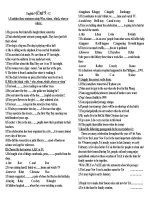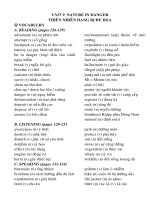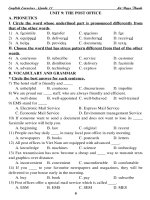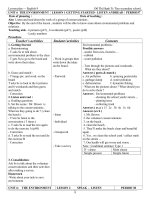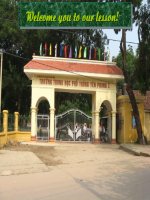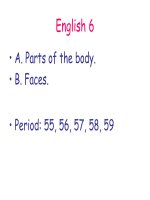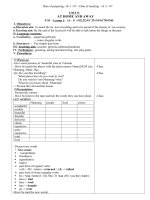Unit 9 Advanced-NTP
Bạn đang xem bản rút gọn của tài liệu. Xem và tải ngay bản đầy đủ của tài liệu tại đây (182.55 KB, 19 trang )
Gi¸o ¸n tiÕng anh 12 n©ng cao GV:
Ng« ThÞ Phîng
Unit 9 : Deserts
Period: 73 Lesson 1: Reading Teaching date: 5/ 1/ 2009
*/ Objectives: By the end of the lesson, SS are able to get some knowledge about deserts
and how to prevent desertification.
*/ Teaching aids: Textbook, handouts, drawings
*/ Procedures:
Time T’s activities Ss’ activities
2’
A/ Organization
- Greeting
- Checking attendance
- Greeting
- Monitor reports the class
attendance.
B/ Checking the old lesson
(No checking)
5’
35’
C/ New Lesson
I- Warm-up:
() Questions:
- Ask SS to discuss and answer the 2 Qs
below:
1, What is the largest desert in the world?
2, What make the deserts tend to expand?
Transition: You know, with changes in
temprature the deserts tend to expand. Today
we’ll study the causes of desert expansion
and how to prevent it.
II- Pre-reading:
() Brainstorming:
- Ask SS to give ideas on what they know
about deserts.
- Note down SS’ ideas and check with the
class.
() Matching deserts with locations
(Task a, p.114)
- Tell SS to look at the marked places on
the world map and then match the
deserts with their locations.
- Discuss the Qs.
- Give answers
- Listen
- Give ideas about deserts.
- Look at the marked places
on the world map in the
textbook and match the
deserts with their locations.
Tu Son High School academic year: 2008 -2009
Deserts
Gi¸o ¸n tiÕng anh 12 n©ng cao GV:
Ng« ThÞ Phỵng
- Call on SS to give answers and check
with the class.
*/ Expected answers:
1. The Gobi Desert: in Mongolia
2. The Great Sandy Desert: in Australia
3. The Mojave Desert: in California
4. The Sahara Desert: in Africa
() T/ F statements about deserts:
(Task b, p.114)
- Ask SS to work in pairs and decide whether
the statements about deserts are T or F.
- Check with the class.
*/ Expected answers:
1. F (Water is formed under the stones during
the night. A lot more water can be found in an
oasis in the desert. Besides, there is rain in
the desert, thuogh not very much)
2. T (The Gobi Desert is a kind of cold deserts
because it has very cold winters several
months a year)
3. F (Camels mainly live in Asian and African
deserts)
4. F (Camels’ humps store fat that can turn
into food to help them survive when crossing
the desert)
5. T (Although we can find lots of other kinds
of desert plants, cacti are the most popular)
() Teaching Vocabulary:
- Pre-teach some vocab. Through elicitation
and explanations.
+ expansion /ik’sp„n∫n/ mở rộng ra
+ herd /hз:d/ (n) bầy gia súc
+ turn into: biến thành
+ dune // (n) đụn cát
+ fix /fiks/ (v) cố đònh
+ fixation /fik’sei∫n / (n) sự cố đònh
+ advance /əd’v„ns/ (v) tiến tới, tăng trưởng
+ brushwood /br/ (n) cành cây gãy
+ bury // (v) chôn vùi
+ pour // (v) đổ, rót
- Give answers.
- Copy.
- Within pairs, discuss
whether the statements are
T or F.
- Give answers.
- Copy.
- Listen and note down.
Tu Son High School academic year: 2008 -2009
Gi¸o ¸n tiÕng anh 12 n©ng cao GV:
Ng« ThÞ Phỵng
+ retain // (v) giữ lại
+ pipeline // (n) đường ống
+ topsoil // (n) lớp đất trên mặt
+ wash away // cuốn trôi
- Have SS some practice on pronunciation.
() Talking about the pictures (Task c, p.114)
- Put SS into pairs.
- Tell SS to discuss what happened to the
places and people in the pictures.
- Call on SS to give their ideas.
- Invite the class to give opinions and
encourage them to give more ideas.
- Give feedback and comment.
*/ Expected answers:
1. Picture A: arid, parched land due to lack of
water.
2. Picture B: sandstorm (in Beijing, China)-
the wind blows sand from the desert into the
city, people have to wear masks.
3. Picture C: a house is buried in the sand-the
house owner is standing near the roof of his
house.
III- While-reading:
(1) Reading the text:
- Read the text and tell the text content
briefly in Vietnamese.
- Practice reading.
- Work in pairs.
- Discuss what happened to
the places and people in the
pictures.
- Give ideas.
- Copy.
- Look at the textbook and
listen to the T’s reading.
2’
D/ Consolidation
- Summarize main points.
-Listen
1’
E/ Homework
- Design HW:
1, Learn by heart New Words.
2, Prepare Tasks a+b+c on pages 115-116.
- Copy
Tu Son High School academic year: 2008 -2009
Gi¸o ¸n tiÕng anh 12 n©ng cao GV:
Ng« ThÞ Phîng
Unit 9 : Deserts
Period: 74 Lesson 2: Reading (Cont’) Teaching date: 6/ 1/
2009
*/ Objectives: By the end of the lesson, SS are able to:
- read for specific details.
- read for gist or general ideas.
*/ Teaching aids: Textbook, handouts, drawings
*/ Procedures:
Time T’s activities Ss’ activities
2’
A/ Organization
- Greeting
- Checking attendance
- Greeting
- Monitor reports the class
attendance.
6’
B/ Checking the old lesson
- Call on 2 SS to go to the board and write
new words they learnt in the previous period.
- Invite class opinions and comment.
- Give mark.
- Go to the board and write new
words.
34’
c/ new lesson
III- While-reading
(2) Questions and answers
(Task a, p.115)
- Ask SS to read the text and find the answers
to the questions.
- Tell SS to work with a partner, asking and
answering the questions.
- Call on some pairs to ask and answer and
check with the class.
*/ Expected answers:
1, People cut down trees for fuel and
farmland; their herds (horses, cattle) eat up
the grass covering the soil.
2, “Dune fixation” is the method of fixing
sand dunes or stopping them from moving
forward.
3, Beijing is affected by the Gobi Desert
- Individually read the text and
answer the Qs.
- Work in pairs – Role play.
- Present.
- Copy.
Tu Son High School academic year: 2008 -2009
Gi¸o ¸n tiÕng anh 12 n©ng cao GV:
Ng« ThÞ Phîng
when strong winds blow sand and dust from
the desert into the city 30 to 40 days a year.
4, The method of poring oil on sandy areas to
retain water for planting trees is harmful to
the environment.
(3) Describing the pictures
(Task b, p.115)
- Tell SS the pictures are about some of the
ways to solve the problem of desert
expension.
- Ask SS to refer to the text to make
sentences to describe the pictures.
- Tell SS to work with a partner and compare
answers.
- Call on SS to read out their descriptions.
- Invite class opinions and comments.
- Give feedback and comments.
*/ Expected answers:
(Picture B) People plant trees.
(Picture C) The local government bans
burning firewood for fuel.
(Picture D) Other countries build long
pipelines to carry water to desert
areas.
(Picture E) Other countries build long canals
to carry water to desert areas.
(Picture F) People make stone lines along the
route of rainwater to catch up
rainwater and prevent topsoil
from washing away.
IV/ Post-reading.
Completing the summary.
(Task c, p.116)
- Ask SS to read the summary of the text and
fill in each space with the missing
information.
- Tell SS to refer to the text if necessary.
- Tell SS to use no more than 3 words in each
space.
- When they have finished, ask SS to work
with a partner and compare answers.
- Listen to the teacher’s
explanation.
- Describe the pictures by making
sentences.
- Work in pairs then compare the
answers with others.
- Read out the descriptions.
- Copy.
- Individually read the summary
of the text and fill in the space
with the missing information, use
no more than 3 words in each
space.
- Work in pairs then compare the
answers with others’
Tu Son High School academic year: 2008 -2009
Gi¸o ¸n tiÕng anh 12 n©ng cao GV:
Ng« ThÞ Phîng
- Call on SS to give their answers.
- Go over the answers with the class.
*/ Expected answers:
1, expansion 5, banning burning firewood
2, efforts 6, pouring thin oil
3, fixing 7, temporary
4, building 8, canals or pipelines
- Copy.
2’
d/ consolidation
- Summarize main points.
Listen.
1’
e/ homework
- Ask SS to do Task d, p.116.
Copy.
Tu Son High School academic year: 2008 -2009
Gi¸o ¸n tiÕng anh 12 n©ng cao GV:
Ng« ThÞ Phîng
Unit 9 : Deserts
Period: 75 Lesson 3: Listening Teaching date: 7/ 1/ 2009
Tu Son High School academic year: 2008 -2009
